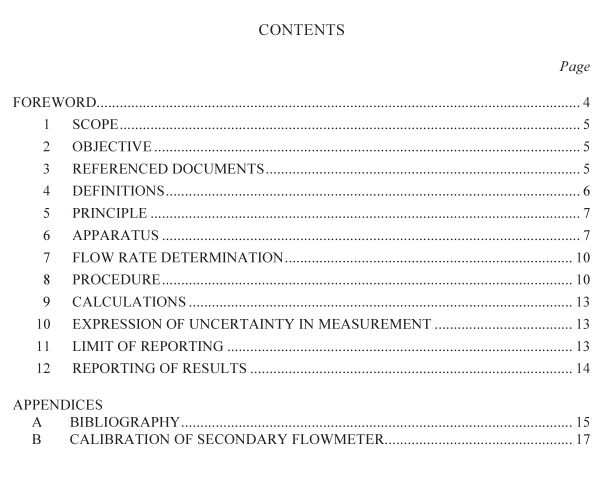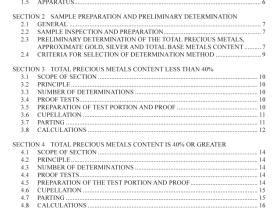AS 2985 pdf download – Workplace atmospheres—Method for sampling and gravimetric determination of respirable dust

AS 2985 pdf download – Workplace atmospheres—Method for sampling and gravimetric determination of respirable dust
6.5Secondary flowmeter
A flowmeter or any secondary device such as a rotameter or electronic flowmeter shall becalibrated against the primary flowmeter as set out in Appendix B. The secondaryflowmeter shall be used to measure the flow rate of the sampling train immediately beforeand after sampling. The secondary flowmeter shall be re-calibrated whenever it is to beoperated under conditions substantially different from those of the previous calibration.Forexample—
(a)when sampling and/or flow rate determination is conducted at an altitude differing by
more than 500 m or at a temperature differing by more than 15°C from that at theprevious calibration; or
(b) when experience indicates such re-calibration is necessary due to stability andmaintenance history of the flowmeter.
NOTES:
1 lt is generally not possible to simply calculate the different flow rates that will inevitablyresult from a change of conditions such as those given above.
2Rotameters can give incorrect readings due to sticking of the float, high humidity and usein a non-vertical position, or under conditions of vibration.
3Errors can occur using electronic flowmeter due to adverse environmental conditions.6.6Timing device
A stopwatch or other timing device capable of measuring elapsed time within 1% of trueelapsed time.
6.7 Microbalance6.7.1 General
A five-place microbalance with a scale division of 10 ug or six-place microbalance with ascale division of l ug. A standard laboratory four-place analytical balance is not suitablefor this application.
6.7.2 Microbalance calibration
The following requirements and recommendations apply:
(a) The microbalance shall be calibrated every three years,using the following
principles, by either—
(i)a suitable accredited testing authority; or
(ii)competent staff employing test methods as described by Morris and Fen.
(b)Tests for departure from nominal linearity shall be conducted for at least 5 and
preferably 10 points from zero up to not more than 50 or 100 mg. If the measureddeparture from nominal linearity exceeds the expanded uncertainty of the referenceweights, the balance should be serviced, or appropriate corrections should be made.(c)Hysteresis and,where applicable, off-centre pan loading shall be conducted using a
weight in the range of 50 to 100 mg. Any hysteresis and off-centre effects greaterthan the scale of the balance should be rectified by servicing,or by an appropriatechange in operating procedures.
(d)Repeatability tests on the microbalance shall be conducted with a weight not smaller
than around the working range used for weighing filters, and not greater than 50 mg,every six months, e.g. in accordance with Morris and Fen.
(e)A limit of performance shall be calculated whenever a full calibration of the balance
is performed.
6.8Static eliminator
Suitable instruments for eliminating static include the following, any of which may be used:(a)an ionising electrode static elimination bar or U-shaped electrode;
(b)a high voltage corona discharge device; or
(c) a positive ion or an alpha particle source ionizing unit
(Americium 241 of 0.4 to 4 MBq activity or Polonium 210 of 20 MBq activity). ThePo unit should be renewed when found to be ineffective (i.e. generally every one totwo years). Both units will require a government licence to operate/dispose of them.7 FLOW RATE DETERMINATION
The sampling pump battery should be re-charged or the dry cells replaced and, if necessary,the pump should be run for up to 15 min in a clean atmosphere immediately before flowrate determination. It is advisable to stabilize the flow rate through a ‘warm-up’sampler,which is not otherwise used,e.g. in calibration to reduce the risk of contamination.Someautomatic flow control pumps require little or no settling-in period.
The pump flow rate should be adjusted accurately to the designated flow rate (see Table 2)using a calibrated flowmeter (see Clause 6.5). Immediately prior to determining the flowrate, disconnect the warm-up sampler and connect the sampling train to be used in the field.The calibration equipment and technique should be of such accuracy that the flow rate canbe measured to within ±5%.
8PROCEDURE
8.1Routine weighing checks
The accuracy of the microbalance used in the gravimetric measurements shall be checked inthe following manner:
(a)Before every weighing session Before weighing the filters:
(i) Ensure the balance is switched on for the manufacturer’s recommended warmup period or at least 30 minutes.
(ii) Exercise the balance by placing a mass of near full load on the pan at least once.
(ii) Check the balance with a reference weight at or near to the working range of the weighing filters and not greater than 50 mg.
(iv) lf the weight reading is grossly different from the nominal value,then the balance shall be serviced.









